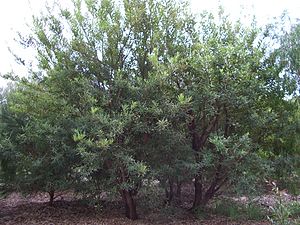Wonnich facts for kids
Callistachys lanceolata, often called the Wonnich or Native Willow, is a type of tree or shrub. It grows naturally in the South West part of Australia.
Quick facts for kids Wonnich |
|
|---|---|
 |
|
| Scientific classification | |
| Kingdom: | |
| (unranked): | |
| (unranked): | |
| (unranked): | |
| Order: | |
| Family: | |
| Genus: |
Callistachys
|
| Species: |
C. lanceolota
|
| Binomial name | |
| Callistachys lanceolata |
|
Contents
What Does the Wonnich Plant Look Like?
The Wonnich is an evergreen plant. This means it keeps its leaves all year round. It can grow as a tree or a shrub. It usually reaches a height of about 1.5 to 7 meters (5 to 23 feet).
Flowers and Leaves
The plant has bright, eye-catching yellow flowers. These flowers grow in clusters called racemes. You can see them blooming during the spring season. This is typically from September to January.
The leaves of the Wonnich plant feel a bit like leather. They grow in groups, usually with three leaves in a circle. Each leaf is generally 40 to 170 millimeters (1.6 to 6.7 inches) long. They are also 4 to 30 millimeters (0.16 to 1.2 inches) wide. The leaves have pointed tips.
Where Does Wonnich Grow in Australia?
The C. lanceolata plant is found in the South West corner of Western Australia. It also grows along the South Coast.
Preferred Growing Spots
This plant likes to grow in sandy soils. It especially thrives in places that are damp. You can often find it along watercourses, in swamps, and near culverts. These are all places where the ground stays moist.
How Scientists Name Plants
The Wonnich plant was first officially described in 1805. A botanist named Étienne Pierre Ventenat gave it its scientific name. He wrote about it in his book called Jardin de la Malmaison .
Scientists sometimes give plants different names over time. For Callistachys lanceolata, it has also been known by other names. These include Oxylobium lanceolatum.
Growing Wonnich Plants from Seeds
If you want to grow Wonnich plants, you can collect their seeds. The seeds are found inside pods. It's best to let these pods dry on the plant first. Once they are dry, you can carefully open them to get the seeds.
Preparing Seeds for Planting
Before you plant the seeds, they need a special treatment. This is called scarification. It means gently scratching or softening the hard outer shell of the seed. This helps the seed soak up water. Soaking water makes it easier for the seed to sprout and grow.

